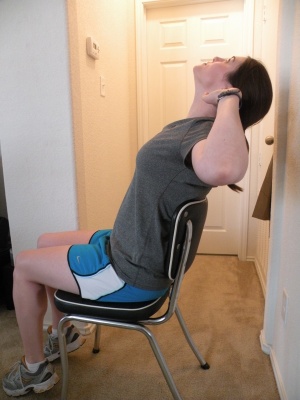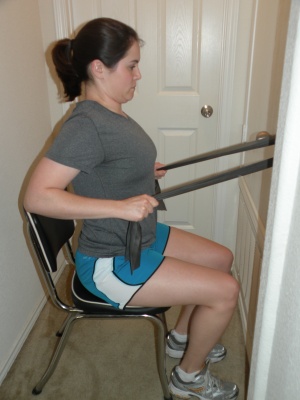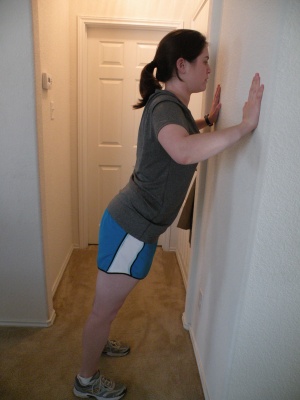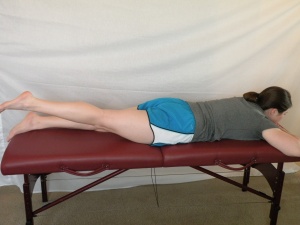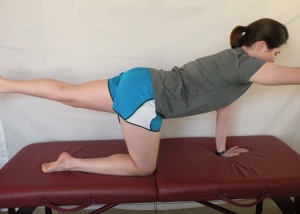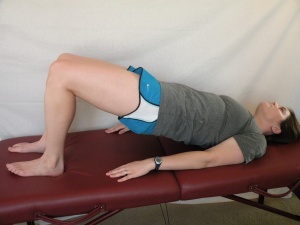Thoracic Spine Fracture: Difference between revisions
Erin Locati (talk | contribs) No edit summary |
mNo edit summary |
||
| Line 53: | Line 53: | ||
'''<br>''' | '''<br>''' | ||
'''Clay-Shoveler's Fracture '''- rare, fatigue fracture of the upper thoracic spinous process. Seen in power lifters or in patients that are involved hard labor causing shear forces on the vertebra, hyperflexed spine, or direct trauma.<ref name="Demir 2007">Demir S, Akin C, Aras M, Koseoglu F. Spinal cord injury associated with thoracic osteoporotic fracture. American Journal of Physical Medicine &amp;amp;amp;amp;amp;amp;amp;amp;amp; Rehabilitation [serial online]. March 2007;86(3):242-246. Available from: CINAHL Plus with Full Text, Ipswich, MA. Accessed April 12, 2011.</ref><br> | '''Clay-Shoveler's Fracture '''- rare, fatigue fracture of the upper thoracic spinous process. Seen in power lifters or in patients that are involved hard labor causing shear forces on the vertebra, hyperflexed spine, or direct trauma.<ref name="Demir 2007">Demir S, Akin C, Aras M, Koseoglu F. Spinal cord injury associated with thoracic osteoporotic fracture. American Journal of Physical Medicine &amp;amp;amp;amp;amp;amp;amp;amp;amp;amp; Rehabilitation [serial online]. March 2007;86(3):242-246. Available from: CINAHL Plus with Full Text, Ipswich, MA. Accessed April 12, 2011.</ref><br> | ||
== Characteristics/Clinical Presentation == | == Characteristics/Clinical Presentation == | ||
| Line 84: | Line 84: | ||
[http://www.physio-pedia.com/index.php5?title=Scheuermann%27s_Kyphosis Scheuermann Disease] presents as exaggerated kyphosis, anterior body extension and schmorl’s nodes; can be distguished by vetebral body height parameters on radiograph. <ref name="Masharawi 2009">Masharawi Y, Rothschild B, Peled N, Hershkovitz I. A simple radiological method for recognizing osteoporotic thoracic vertebral compression fractures and distinguishing them from Scheuermann disease. Spine. Aug 2009;34(18):1995-1999.</ref> | [http://www.physio-pedia.com/index.php5?title=Scheuermann%27s_Kyphosis Scheuermann Disease] presents as exaggerated kyphosis, anterior body extension and schmorl’s nodes; can be distguished by vetebral body height parameters on radiograph. <ref name="Masharawi 2009">Masharawi Y, Rothschild B, Peled N, Hershkovitz I. A simple radiological method for recognizing osteoporotic thoracic vertebral compression fractures and distinguishing them from Scheuermann disease. Spine. Aug 2009;34(18):1995-1999.</ref> | ||
<sup></sup> | <sup></sup> | ||
== Examination == | == Examination == | ||
| Line 168: | Line 168: | ||
*Physical Therapy | *Physical Therapy | ||
Preventative treatment for fractures related to osteoporosis include bisophosphonates, calcium, vitamin D and exercise.<ref name="Demir 2007">Demir S, Akin C, Aras M, Koseoglu F. Spinal cord injury associated with thoracic osteoporotic fracture. American Journal of Physical Medicine &amp;amp;amp;amp;amp;amp;amp;amp;amp;amp;amp;amp;amp;amp;amp; Rehabilitation [serial online]. March 2007;86(3):242-246. Available from: CINAHL Plus with Full Text, Ipswich, MA. Accessed April 12, 2011.</ref><br> | Preventative treatment for fractures related to osteoporosis include bisophosphonates, calcium, vitamin D and exercise.<ref name="Demir 2007">Demir S, Akin C, Aras M, Koseoglu F. Spinal cord injury associated with thoracic osteoporotic fracture. American Journal of Physical Medicine &amp;amp;amp;amp;amp;amp;amp;amp;amp;amp;amp;amp;amp;amp;amp;amp; Rehabilitation [serial online]. March 2007;86(3):242-246. Available from: CINAHL Plus with Full Text, Ipswich, MA. Accessed April 12, 2011.</ref><br> | ||
Wood et al found no significant long-term difference in pain, disability and return to work for non-neurologically involved patients who received surgery compared to those who received bracing or casting. This indicates that the higher risk and cost of surgery may not be justified and that bracing/casting would be the preferred treatment in this patient population.<ref name="Wood 2003">Wood K, Butterman G, Mehbod A, Garvey T, Jhanjee R, Sechriest V. Operative compared to nonoperative treatment of thoracolumbar burst fracture without neurological deficit: A prospective, randomized study. J Bone Joint Surg Am. 2003; 85-A(5): 773-781.</ref> Braces are a common component of both post-operative and non-operative thoracic fracture treatment protocols.<ref name="Giele 2009" /><br> | Wood et al found no significant long-term difference in pain, disability and return to work for non-neurologically involved patients who received surgery compared to those who received bracing or casting. This indicates that the higher risk and cost of surgery may not be justified and that bracing/casting would be the preferred treatment in this patient population.<ref name="Wood 2003">Wood K, Butterman G, Mehbod A, Garvey T, Jhanjee R, Sechriest V. Operative compared to nonoperative treatment of thoracolumbar burst fracture without neurological deficit: A prospective, randomized study. J Bone Joint Surg Am. 2003; 85-A(5): 773-781.</ref> Braces are a common component of both post-operative and non-operative thoracic fracture treatment protocols.<ref name="Giele 2009" /><br> | ||
| Line 174: | Line 174: | ||
'''Discussion'''<br>Alpantaki et al proposed a treatment algorithm for patients presenting with thoracolumbar burst fractures that is based on the patient’s neurological status. Incomplete neurological impairment indicated the need for surgery whereas a patient without neurological deficits could be conservatively managed. Within the surgery category, it’s recommended that patients without PLC compromise receive an anterior surgical approach, those with thoracic kyphosis >35° receive a posterior surgical approach, and those with complete PLC compromise might benefit from a combined anterior and posterior approach.<ref name="Alpantaki 2010" /> | '''Discussion'''<br>Alpantaki et al proposed a treatment algorithm for patients presenting with thoracolumbar burst fractures that is based on the patient’s neurological status. Incomplete neurological impairment indicated the need for surgery whereas a patient without neurological deficits could be conservatively managed. Within the surgery category, it’s recommended that patients without PLC compromise receive an anterior surgical approach, those with thoracic kyphosis >35° receive a posterior surgical approach, and those with complete PLC compromise might benefit from a combined anterior and posterior approach.<ref name="Alpantaki 2010" /> | ||
<br>There is a lack of evidence for the use of conservative treatments in neurologically involved patients as neurological involvement is typically an exclusion criteria in studies on conservative treatment.<ref name="Wood 2003" /><ref name="Alpantaki 2010" /><ref name="Giele 2009" /> However, Weninger et al reported positive outcomes for a select group of patients with unilateral radicular symptoms that refused surgery in favor conservative treatment (closed reduction followed by casting). Patients with more serious neurological involvement such as cauda equina symptoms did not respond as well to the same conservative treatment.<ref name="Weninger 2009" /><br> | <br>There is a lack of evidence for the use of conservative treatments in neurologically involved patients as neurological involvement is typically an exclusion criteria in studies on conservative treatment.<ref name="Wood 2003" /><ref name="Alpantaki 2010" /><ref name="Giele 2009" /> However, Weninger et al reported positive outcomes for a select group of patients with unilateral radicular symptoms that refused surgery in favor conservative treatment (closed reduction followed by casting). Patients with more serious neurological involvement such as cauda equina symptoms did not respond as well to the same conservative treatment.<ref name="Weninger 2009" /><br> | ||
== Physical Therapy Management (current best evidence) == | == Physical Therapy Management (current best evidence) == | ||
Management of vertebral fractures remains controversial <ref name="Alpantaki 2010" /><sup>,</sup><ref name="Van Leeuwen 2000">Van Leeuwen PJ, Bos RP, Derksen JC, de Vries J. Assessment of spinal movement reduction by thoraco-lumbar-sacral orthoses: Journal of Rehabilitation Research and Development. 2000; 37(4): 395-403</ref><sup>,</sup><ref name="Dai 2009">Dai LY, Jiang LS, Jiang SD. Posterior short-segment fixation with or without fusion for thoracolumbar burst fractures. A five to seven-year prospective randomized study: J Bone Joint Surg Am. 2009; 91: 1033-1041</ref> and research is limited on identifying physical therapy intervention. Until recently, conservative management of fractures consisted of pain medications, rest and bracing to reduce spinal movements <ref name="Rousing 2010">Rousing R, Hansen KL, Andersen M, Jespersen SM, Thomsen K, Lauritsen JM. Twelve-months follow-up in forty-nine patients with acute/semiacute osteoporotic vertebral fractures treated conservatively or with percutaneous vertebroplasty: SPINE. 2010; 35(5): 478-482</ref><sup>,</sup><ref name="Van Leeuwen 2000" /><sup>,</sup><ref name="Cahoj 2007">Cahoj PA, Cook JL, Robinson BS. Efficacy of percutaneous vertebral augmentation and use of physical therapy intervention following vertebral compression fractures in older adults: A systematic review. Journal of Geriatric Physical Therapy. 2007; 30(1): 31-40</ref><sup>,</sup><ref name="Wood 2003" />. <br>Rehabilitation programs must be designed specifically for the individual based on their physical abilities and impairments.<br> | Management of vertebral fractures remains controversial <ref name="Alpantaki 2010" /><sup>,</sup><ref name="Van Leeuwen 2000">Van Leeuwen PJ, Bos RP, Derksen JC, de Vries J. Assessment of spinal movement reduction by thoraco-lumbar-sacral orthoses: Journal of Rehabilitation Research and Development. 2000; 37(4): 395-403</ref><sup>,</sup><ref name="Dai 2009">Dai LY, Jiang LS, Jiang SD. Posterior short-segment fixation with or without fusion for thoracolumbar burst fractures. A five to seven-year prospective randomized study: J Bone Joint Surg Am. 2009; 91: 1033-1041</ref> and research is limited on identifying physical therapy intervention. Until recently, conservative management of fractures consisted of pain medications, rest and bracing to reduce spinal movements <ref name="Rousing 2010">Rousing R, Hansen KL, Andersen M, Jespersen SM, Thomsen K, Lauritsen JM. Twelve-months follow-up in forty-nine patients with acute/semiacute osteoporotic vertebral fractures treated conservatively or with percutaneous vertebroplasty: SPINE. 2010; 35(5): 478-482</ref><sup>,</sup><ref name="Van Leeuwen 2000" /><sup>,</sup><ref name="Cahoj 2007">Cahoj PA, Cook JL, Robinson BS. Efficacy of percutaneous vertebral augmentation and use of physical therapy intervention following vertebral compression fractures in older adults: A systematic review. Journal of Geriatric Physical Therapy. 2007; 30(1): 31-40</ref><sup>,</sup><ref name="Wood 2003" />. <br>Rehabilitation programs must be designed specifically for the individual based on their physical abilities and impairments.<br> | ||
With conservative treatment, the majority of fractures heal with significant decrease in pain in 8-12 weeks. Significant declines in pain (5.9cm on VAS) are experienced 12-24 hours post-surgery <ref name="Rousing 2010" />. Therefore, interventions depend largely on whether the patient chose surgery or conservative treatment. Interventions should always be prescribed and progressed based on patient tolerance. | With conservative treatment, the majority of fractures heal with significant decrease in pain in 8-12 weeks. Significant declines in pain (5.9cm on VAS) are experienced 12-24 hours post-surgery <ref name="Rousing 2010" />. Therefore, interventions depend largely on whether the patient chose surgery or conservative treatment. Interventions should always be prescribed and progressed based on patient tolerance. | ||
<br> | <br> | ||
'''Physical Therapy Goals''' | '''Physical Therapy Goals''' | ||
| Line 194: | Line 194: | ||
*Lower extremity strengthening | *Lower extremity strengthening | ||
<br> | <br> | ||
Bennell et al. found that a multimodal treatment approach over a 10-week period was successful in reducing pain and improving function in patients who suffered from osteoporotic vertebral fractures <ref name="Bennell 2010">Bennell KL, Matthews B, Greig A, Briggs A, Kelly A, Sherburn M, Larsen J, Wark J. Effects of an exercise and manual therapy program on physical impairments, function and quality of life in people with osteoporotic vertebral fracture: A randomised, single-blind controlled pilot trial. BMC Musculoskeletal Disorders. 2010; 11(36) 1-11.</ref>. However, because it was a multimodal approach the effectiveness of each treatment is unclear. | Bennell et al. found that a multimodal treatment approach over a 10-week period was successful in reducing pain and improving function in patients who suffered from osteoporotic vertebral fractures <ref name="Bennell 2010">Bennell KL, Matthews B, Greig A, Briggs A, Kelly A, Sherburn M, Larsen J, Wark J. Effects of an exercise and manual therapy program on physical impairments, function and quality of life in people with osteoporotic vertebral fracture: A randomised, single-blind controlled pilot trial. BMC Musculoskeletal Disorders. 2010; 11(36) 1-11.</ref>. However, because it was a multimodal approach the effectiveness of each treatment is unclear. | ||
<br> | <br> | ||
'''APTA Preferred Practice Patterns'''<ref name="Guide 2003">Guide to Physical Therapist Practice. 2nd ed. Revised. Alexandria, Va: American Physical Therapy Association; 2003</ref>: | '''APTA Preferred Practice Patterns'''<ref name="Guide 2003">Guide to Physical Therapist Practice. 2nd ed. Revised. Alexandria, Va: American Physical Therapy Association; 2003</ref>: | ||
| Line 208: | Line 208: | ||
4I: Impaired Joint Mobility, Muscle Performance, and Range of Motion Associated with Bony or Soft Tissue Surgery | 4I: Impaired Joint Mobility, Muscle Performance, and Range of Motion Associated with Bony or Soft Tissue Surgery | ||
<br> | <br> | ||
'''General Exercise Recommendations''' <ref name="Bennell 2010" /><sup>,</sup><ref name="Guide 2003" /> within a pain free range, progressed as tolerated: | '''General Exercise Recommendations''' <ref name="Bennell 2010" /><sup>,</sup><ref name="Guide 2003" /> within a pain free range, progressed as tolerated: | ||
| Line 218: | Line 218: | ||
[[Image:Scapula Retraction with TheraBand.JPG|thumb|left|Scapular retraction with theraband in sitting + Chin tuck + TA]][[Image:Wall Pushups.JPG|thumb|center|Standing wall pushups]] | [[Image:Scapula Retraction with TheraBand.JPG|thumb|left|Scapular retraction with theraband in sitting + Chin tuck + TA]][[Image:Wall Pushups.JPG|thumb|center|Standing wall pushups]] | ||
<br> | <br> | ||
[[Image:SLR Hip Ext.JPG|thumb|right|Hip extension in prone]]<br> | [[Image:SLR Hip Ext.JPG|thumb|right|Hip extension in prone]]<br> | ||
[[Image:Quadruped Ext.JPG|thumb|left|Four-Point Kneeling + TA]][[Image:Bridge.JPG|thumb|center|Bridging in supine]] | [[Image:Quadruped Ext.JPG|thumb|left|Four-Point Kneeling + TA]][[Image:Bridge.JPG|thumb|center|Bridging in supine]] | ||
<br> | <br> | ||
A major concern is refracture within a year of the initial injury. Researchers agree that strengthening back-extensor muscles can help decrease the rate of refracture or prolong occurance of refracture <ref name="Cahoj 2007" /><sup>,</sup><ref name="Bennell 2010" />.<sup> </sup>Studies show significant improvement in reported pain levels and increased function in patients with back-extensor exercises as part of their exercise regimen <ref name="Cahoj 2007" /><sup>,</sup><ref name="Huntoon 2008">Huntoon EA, Schmidt CK, Sinaki M. Significantly fewer refractures after vertebroplasty in patients who engage in back-extensor-strengthening exercises. Mayo Clin Proc. 2008; 83(1): 54-57</ref><sup>,</sup><ref name="Sinaki 2002">Sinaki M, Itoi E, Wahner HW, Wollan P, Gelzcer R, Mullan BP, Collins DA, Hodgson SF. Stronger Back Muscles Reduce the incidence of vertebral fractures: A prospective 10 year follow-up of postmenopausal women. Bone. 2002; 30(6): 836-841</ref><sup>,</sup><ref name="Bennell 2010" />. Therefore, patient should begin strengthening back-extensor muscles as soon as they are physically able.<br> | A major concern is refracture within a year of the initial injury. Researchers agree that strengthening back-extensor muscles can help decrease the rate of refracture or prolong occurance of refracture <ref name="Cahoj 2007" /><sup>,</sup><ref name="Bennell 2010" />.<sup> </sup>Studies show significant improvement in reported pain levels and increased function in patients with back-extensor exercises as part of their exercise regimen <ref name="Cahoj 2007" /><sup>,</sup><ref name="Huntoon 2008">Huntoon EA, Schmidt CK, Sinaki M. Significantly fewer refractures after vertebroplasty in patients who engage in back-extensor-strengthening exercises. Mayo Clin Proc. 2008; 83(1): 54-57</ref><sup>,</sup><ref name="Sinaki 2002">Sinaki M, Itoi E, Wahner HW, Wollan P, Gelzcer R, Mullan BP, Collins DA, Hodgson SF. Stronger Back Muscles Reduce the incidence of vertebral fractures: A prospective 10 year follow-up of postmenopausal women. Bone. 2002; 30(6): 836-841</ref><sup>,</sup><ref name="Bennell 2010" />. Therefore, patient should begin strengthening back-extensor muscles as soon as they are physically able.<br> | ||
When developing a plan of care, the therapist should consider the individual characteristics of a vertebral fracture and possible secondary limitations. | When developing a plan of care, the therapist should consider the individual characteristics of a vertebral fracture and possible secondary limitations. | ||
| Line 245: | Line 245: | ||
*Loss of Balance<br> | *Loss of Balance<br> | ||
<br> | |||
== Resources <br> == | == Resources <br> == | ||
| Line 255: | Line 255: | ||
[http://www.aofoundation.org/Pages/home.aspx AO Foundation] | [http://www.aofoundation.org/Pages/home.aspx AO Foundation] | ||
[http://emedicine.medscape.com/article/1267029-overview Thoracic Spine Fractures and Dislocation - Medscape Reference] | [http://emedicine.medscape.com/article/1267029-overview Thoracic Spine Fractures and Dislocation - Medscape Reference] | ||
== Clinical Bottom Line == | == Clinical Bottom Line == | ||
| Line 275: | Line 275: | ||
<br> | <br> | ||
[[Category:Texas_State_University_EBP_Project|Template:TXSTEBP]] | [[Category:Texas_State_University_EBP_Project|Template:TXSTEBP]][[Category:Articles]] | ||
Revision as of 16:47, 2 May 2011
Original Editors
Lead Editors - Your name will be added here if you are a lead editor on this page. Read more.
Search Strategy[edit | edit source]
Databases Searched: CINHAL plus Full Text, Cochrane, PubMed
Key Words: thoracic, fracture, thoracolumbar, diagnosis, management, treatment, compression, burst, vertebral
Search Timeline: April 6, 2011 to May 1, 2011
Definition/Description[edit | edit source]
According to the Denis classification system for spinal injury, there are four types of vertebral fracture[1]:
- Compression
- Burst
- Flexion-distraction
- Fracture-dislocation - Subsets include Flexion-Rotation, Flexion-Distraction and Shear
Minor fractures include those of the spinous processes, transverse processes, pars interarticularis, and facet joints.[1]
Some other classification systems that are used include: AO and TLICSS.[2]
NeckandBack.com Text, Video and Graphic Content to Donald Corenman, MD - Spine Surgeon Colorado (http://www.youtube.com/watch?v=7SIry1QXNsA&feature=player_embedded)
Permission granted on 4/29/2011.
Crashed mountain bike off ramp: CT scan
Epidemiology /Etiology[edit | edit source]
Compression – failure of the anterior column of the spine due to compression forces, mainly in flexion. The most common causes in younger patients are falls and motor vehicle accidents. The most common causes in older patients are minor incidents during normal activities of daily living secondary to osteoporosis or metabolic bone diseases.[3] Associated neurological complications are rare[1].
Burst – fracture of the anterior and middle columns of the spine due to axial loading[4] such as from a fall landing on the buttocks or lower extremities. The concentration of axial forces is to the thoracolumbar junction. [5][1]
Flexion-distraction (seat belt injury) – failures of the posterior and middle columns of the spine under tension usually from a trauma involving sudden upper body forward flexion while the lower body remains stationary. Often associated with abdominal trauma due to compression of abdominal cavity during injury. The anterior column may be mildly affected, but the annulus fibrosis and anterior longitudinal ligament are intact, preventing dislocation or subluxation. A gap between the spinous processes is often present upon palpation.[1]
Fracture-dislocation – failure of all three spinal columns under compression, flexion, rotation, or shear forces. The most unstable of all thoracolumbar spine injuries, they are highly associated with neurological deficits. They can be caused by a severe flexion force similar to that of a seat belt injury, or an object falling across the back.[1]
Clay-Shoveler's Fracture - rare, fatigue fracture of the upper thoracic spinous process. Seen in power lifters or in patients that are involved hard labor causing shear forces on the vertebra, hyperflexed spine, or direct trauma.[6]
Characteristics/Clinical Presentation[edit | edit source]
Over 65% of vertebral fractures are asymptomatic [7]. They are sometimes detected via radiograph when a patient is being screened for another injury.
Presentation of symptomatic fractures includes: [7][3][8][9][10][11]
- Chronic back pain in thoracic and/or lumbar region
- Slower gait
- Decreased range of motion
- Impaired pulmonary function
- Increased kyphosis especially in osteoporitic patients with compression fractures
- Neurological deficits due to narrowing of spinal canal - can present as long as 1.5 years post injury
Prolonging of these symptoms leads to decreased physical function and performance of activities of daily living, and increased risk of disability. Vertebral deformities are also associated with significantly increased risk of future fractures, including hip fractures[7].
Patients with non-compression fractures are usually involved in a multi-trauma, and will have various injuries and sources of pain. Clinicians must use their best judgment and employ clinical screening criteria to determine if the thoracic spine is involved.[3]
Differential Diagnosis[edit | edit source]
Plain radiographs are historically the "gold standard" for detecting thoracolumbar fractures, although due to the organs and soft tissue in the thoracic region, fractures can be missed on radiographs. A CT scan is recommended to visualize thoracic fractures and an MRI to assess soft tissue damage. [12][8][9]
Multiple Myeloma and other cancers can present as thoracic pain, but will have additional signs such as unexplained weight loss and fever.[13]
Scheuermann Disease presents as exaggerated kyphosis, anterior body extension and schmorl’s nodes; can be distguished by vetebral body height parameters on radiograph. [14]
Examination[edit | edit source]
Screening for Fracture
Algorithms for screening patients for thoracic fractures and the need for imaging have been developed but not fully validated.
O'Connor and Walsham (2009)
Presence of one or more of the following criteria in a patient with blunt multi-trauma is an indication for thoracolumbar imaging (Sn=0.99)[3]:
| High-Risk Mechanism of Injury (MOI) |
Motor vehicle accident at speed >70 kph, fall from height >3 m, ejection from motor vehicle or motorcycle, plus any injury outside of these criteria that could cause a thoracolumbar fracture |
| Painful Distracting Injury |
Painful torso or long-bone injury sufficient to distract the patient from noticing the pain of the thoracolumbar injury |
| New Neurological Signs or Back Pain/Tenderness |
Clinical findings suspicious of new vertebral fracture, including back pain, back tenderness, a palpable step in vertebral palpation, midline bruising, neurological signs consistent with spinal cord injury |
| Cognitive Impairment |
Glasgow Coma Score (GCS) < 15, abnormal mentation, clinical intoxication |
| Known Cervical Spine Fracture |
Evidence of a new traumatic cervical spine fracture |
These results were derived from low-level evidence. The authors recommend future controlled trials to standardize these definitions and validate the algorithm.[3]
Holmes et al: Screening criteria for radiograph of blunt trauma patients with thoracolumbar injuries (Sn=1.00, Sp=0.039)[10] :
- Complaints of thoracolumbar spine pain
- Thoracolumbar spine tenderness
- Decreased level of consciousness
- Intoxication with alcohol or drugs
- Neurologic deficit
- Painful distracting injury
Singh et al:
Three predictive variables for thoracic spine fracture based on a case control study (Sp=0.93)[9]:
- Fall > 2m
- Thoracic pain
- Intoxication
Physical Therapy Exam
- Thorough history including MOI and previous spine fractures
- Neurological screen
- Assessment of patient's pain level and location
- Palpation of the thoracic spine
- Screen for thoracic fracture
- Identification of impairments in ROM, Strength, Flexibility
Medical Management (current best evidence)[edit | edit source]
Operative
Indications for surgery include neurological involvement and/or progressive neurological deterioration, >50% spinal canal compromise, >50% anterior vertebral body height loss, >25° to 35° angle of kyphotic deformity, and posterior ligament complex (PLC) compromise. Surgical approaches can be anterior, posterior or a combination.[5] For more information on spine surgery refer to:
Nonoperative
Compression fractures, stable burst fractures and neurologically intact patients can typically be treated non-operatively:[5][15][16][17][18]
- Bed Rest/Activity Limitation ranging from days to weeks
- Bracing: 8 to 12 weeks in Jewett or Cruciform Anterior Spinal Hyperextension (CASH) File:Jewett & CASH Braces.JPGJewett (left) & CASH (right) Braces - courtesy of Orthotic & Prosthetic Technologies, Inc., San Marcos, TX
- Casting: 8 to 12 weeksFile:CASH & Jewett Braces on Patients.JPGCASH (left) & Jewett (right) Braces - courtesy of Orthotic & Prosthetic Technologies, Inc., San Marcos, TX
- Closed reduction
- Pain medication
- Physical Therapy
Preventative treatment for fractures related to osteoporosis include bisophosphonates, calcium, vitamin D and exercise.[6]
Wood et al found no significant long-term difference in pain, disability and return to work for non-neurologically involved patients who received surgery compared to those who received bracing or casting. This indicates that the higher risk and cost of surgery may not be justified and that bracing/casting would be the preferred treatment in this patient population.[16] Braces are a common component of both post-operative and non-operative thoracic fracture treatment protocols.[18]
Discussion
Alpantaki et al proposed a treatment algorithm for patients presenting with thoracolumbar burst fractures that is based on the patient’s neurological status. Incomplete neurological impairment indicated the need for surgery whereas a patient without neurological deficits could be conservatively managed. Within the surgery category, it’s recommended that patients without PLC compromise receive an anterior surgical approach, those with thoracic kyphosis >35° receive a posterior surgical approach, and those with complete PLC compromise might benefit from a combined anterior and posterior approach.[5]
There is a lack of evidence for the use of conservative treatments in neurologically involved patients as neurological involvement is typically an exclusion criteria in studies on conservative treatment.[16][5][18] However, Weninger et al reported positive outcomes for a select group of patients with unilateral radicular symptoms that refused surgery in favor conservative treatment (closed reduction followed by casting). Patients with more serious neurological involvement such as cauda equina symptoms did not respond as well to the same conservative treatment.[17]
Physical Therapy Management (current best evidence)[edit | edit source]
Management of vertebral fractures remains controversial [5],[19],[20] and research is limited on identifying physical therapy intervention. Until recently, conservative management of fractures consisted of pain medications, rest and bracing to reduce spinal movements [21],[19],[22],[16].
Rehabilitation programs must be designed specifically for the individual based on their physical abilities and impairments.
With conservative treatment, the majority of fractures heal with significant decrease in pain in 8-12 weeks. Significant declines in pain (5.9cm on VAS) are experienced 12-24 hours post-surgery [21]. Therefore, interventions depend largely on whether the patient chose surgery or conservative treatment. Interventions should always be prescribed and progressed based on patient tolerance.
Physical Therapy Goals
- Reduce pain
- Improve posture
- Improve thoracic mobility
- Strengthen trunk extensors
- Improve trunk control
- Provide education
- Lower extremity strengthening
Bennell et al. found that a multimodal treatment approach over a 10-week period was successful in reducing pain and improving function in patients who suffered from osteoporotic vertebral fractures [23]. However, because it was a multimodal approach the effectiveness of each treatment is unclear.
APTA Preferred Practice Patterns[24]:
4B: Impaired Posture
4G:Impaired Joint Mobility, Muscle Performance, and Range of Motion Associated with Fracture
4I: Impaired Joint Mobility, Muscle Performance, and Range of Motion Associated with Bony or Soft Tissue Surgery
General Exercise Recommendations [23],[24] within a pain free range, progressed as tolerated:
Refer to Bennell et al (2010) [23]
Table 1 Physiotherapy and home exercise program
A major concern is refracture within a year of the initial injury. Researchers agree that strengthening back-extensor muscles can help decrease the rate of refracture or prolong occurance of refracture [22],[23]. Studies show significant improvement in reported pain levels and increased function in patients with back-extensor exercises as part of their exercise regimen [22],[25],[26],[23]. Therefore, patient should begin strengthening back-extensor muscles as soon as they are physically able.
When developing a plan of care, the therapist should consider the individual characteristics of a vertebral fracture and possible secondary limitations.
Complications to Consider [5],[20],[22]:
- Cardiorespiratory compromise
- Additional Fractures
- Refractures
- Osteoporosis
- Prolonged Pain
- Limited Range of Motion
- Limited Strength
- Neurological Compromise
- Postural Dysfunction
- General Deconditioning
- Gait/Ambulation Abnormalities
- Loss of Balance
Resources
[edit | edit source]
Thoracic Spine Fractures and Dislocation - Medscape Reference
Clinical Bottom Line[edit | edit source]
There is a lack of high quality evidence for the management of thoracic spine fractures. Physical therapists should be familiar with screening for thoracic fractures and take an impairment-based approach when treating post-operative or non-operative patients.
Recent Related Research (from Pubmed)[edit | edit source]
Failed to load RSS feed from http://eutils.ncbi.nlm.nih.gov/entrez/eutils/erss.cgi?rss_guid=1ViHQ7Py-pzujQkDXgvEGkfufniZql6E0rEmhwfdWQwaPDas6OD|charset=UTF-8|short|max=10: Error parsing XML for RSS
References[edit | edit source]
see adding references tutorial.
- ↑ 1.0 1.1 1.2 1.3 1.4 1.5 Kandabarow A. Clinical excerpts... Injuries of the thoracolumbar spine... reprinted from Alexander Kandabarow, Injuries of the Thoracolumbar Spine, Topics in Emergency Medicine, vol. 19, no. 3, pp. 65-80, (C)1997 Aspen Publishers, Inc.
- ↑ Wood K, Khanna G, Vaccaro A, Arnold P, Harris M, Mehbod A. Assessment of two thoracolumbar fracture classification systems as used by multiple surgeons. J Bone Joint Surg (AM). July 2005;87A(7):1423-1429.
- ↑ 3.0 3.1 3.2 3.3 3.4 O'Connor E, Walsham J. Indications for thoracolumbar imaging in blunt trauma patients: A review of current literature. Emerg Med Australas. April 2009;21(2):94-101.
- ↑ Tisot R, Avanzi O. Laminar fractures as a severity marker in burst fractures of the thoracolumbar spine. J Orthop Surg (Hong Kong). December 2009;17(3):261-264.
- ↑ 5.0 5.1 5.2 5.3 5.4 5.5 5.6 Alpantaki K, Bano A, Pasku D, Mavrogenis AF, Papagelopoulos PJ, Sapkas G, Korres D, Katonis P. Thoracolumbar burst fractures: A systematic review of management. Orthopedics. 2010; 33(6): 422-429.
- ↑ 6.0 6.1 Demir S, Akin C, Aras M, Koseoglu F. Spinal cord injury associated with thoracic osteoporotic fracture. American Journal of Physical Medicine &amp;amp;amp;amp;amp;amp;amp;amp;amp; Rehabilitation [serial online]. March 2007;86(3):242-246. Available from: CINAHL Plus with Full Text, Ipswich, MA. Accessed April 12, 2011. Cite error: Invalid
<ref>tag; name "Demir 2007" defined multiple times with different content - ↑ 7.0 7.1 7.2 Lentle B, Brown J, Hodsman A, et al. Recognizing and reporting vertebral fractures: reducing the risk of future osteoporotic fractures. Can Assoc Radiol J. February 2007;58(1):27.
- ↑ 8.0 8.1 Marre B, Ballesteros V, Martinez C, Zamorano JJ, Ilabaca F, Munjin M, Yurac R, Urzua A, Lecaros M, Fleiderman J. Thoracic spine fractures: Injury profile and outcomes of a surgically treated cohort. Eur Spine J. Published online January 2011.
- ↑ 9.0 9.1 9.2 Singh R, Taylor DM, D’Souza D, Gorelik A, Page P, Phal P. Mechanism of injury and clinical variables in thoracic spine fracture: A case control study. Hong Kong J Emerg Med. 2011; 18(1): 5-12.
- ↑ 10.0 10.1 Holmes JF et al. Prospective evaluation of criteria for obtaining thoracolumbar radiographs in trauma patients. J Emerg Med. 2003; 24:1-7.
- ↑ Friedrich M, Gittler G, Pieler-Bruha E. Misleading history of pain location in 51 patients with osteoporotic vertebral fractures. Eur Spine J. December 2006;15(12):1797-1800.
- ↑ Diaz J, Cullinane D, Vaslef S, et al. Practice management guidelines for the screening of thoracolumbar spine fracture. J Trauma. Sept 2007;63(3):709-718.
- ↑ PubMed Health: Multiple myeloma Web site. Available at: http://www.ncbi.nlm.nih.gov/pubmedhealth/PMH0001609/. Accessed April 29, 2001.
- ↑ Masharawi Y, Rothschild B, Peled N, Hershkovitz I. A simple radiological method for recognizing osteoporotic thoracic vertebral compression fractures and distinguishing them from Scheuermann disease. Spine. Aug 2009;34(18):1995-1999.
- ↑ Shaffrey CI, Shaffrey ME, Whitehill R, Nockels RP. Surgical treatment of thoracolumbar fractures. Neurosurg Clin N Am. 1997; 8(4): 519-540.
- ↑ 16.0 16.1 16.2 16.3 Wood K, Butterman G, Mehbod A, Garvey T, Jhanjee R, Sechriest V. Operative compared to nonoperative treatment of thoracolumbar burst fracture without neurological deficit: A prospective, randomized study. J Bone Joint Surg Am. 2003; 85-A(5): 773-781.
- ↑ 17.0 17.1 Weninger P, Schultz A, Hertz H. Conservative management of thoracolumbar and lumbar spine compression and burst fractures: Functional and radiographic outcomes in 136 cases treated by closed reduction and casting. Arch Orthop Trauma Surg. 2009; 129: 207-219.
- ↑ 18.0 18.1 18.2 Giele BM, Wiertsema SH, Beelen A, va der Schaaf M, Lucas C, Been HD, Bramer JA. No evidence for the effectiveness of bracing in patients with thoracolumbar fractures: A systematic review. Acta Orthopaedica. 2009; 80(2): 226-232.
- ↑ 19.0 19.1 Van Leeuwen PJ, Bos RP, Derksen JC, de Vries J. Assessment of spinal movement reduction by thoraco-lumbar-sacral orthoses: Journal of Rehabilitation Research and Development. 2000; 37(4): 395-403
- ↑ 20.0 20.1 Dai LY, Jiang LS, Jiang SD. Posterior short-segment fixation with or without fusion for thoracolumbar burst fractures. A five to seven-year prospective randomized study: J Bone Joint Surg Am. 2009; 91: 1033-1041
- ↑ 21.0 21.1 Rousing R, Hansen KL, Andersen M, Jespersen SM, Thomsen K, Lauritsen JM. Twelve-months follow-up in forty-nine patients with acute/semiacute osteoporotic vertebral fractures treated conservatively or with percutaneous vertebroplasty: SPINE. 2010; 35(5): 478-482
- ↑ 22.0 22.1 22.2 22.3 Cahoj PA, Cook JL, Robinson BS. Efficacy of percutaneous vertebral augmentation and use of physical therapy intervention following vertebral compression fractures in older adults: A systematic review. Journal of Geriatric Physical Therapy. 2007; 30(1): 31-40
- ↑ 23.0 23.1 23.2 23.3 23.4 Bennell KL, Matthews B, Greig A, Briggs A, Kelly A, Sherburn M, Larsen J, Wark J. Effects of an exercise and manual therapy program on physical impairments, function and quality of life in people with osteoporotic vertebral fracture: A randomised, single-blind controlled pilot trial. BMC Musculoskeletal Disorders. 2010; 11(36) 1-11.
- ↑ 24.0 24.1 Guide to Physical Therapist Practice. 2nd ed. Revised. Alexandria, Va: American Physical Therapy Association; 2003
- ↑ Huntoon EA, Schmidt CK, Sinaki M. Significantly fewer refractures after vertebroplasty in patients who engage in back-extensor-strengthening exercises. Mayo Clin Proc. 2008; 83(1): 54-57
- ↑ Sinaki M, Itoi E, Wahner HW, Wollan P, Gelzcer R, Mullan BP, Collins DA, Hodgson SF. Stronger Back Muscles Reduce the incidence of vertebral fractures: A prospective 10 year follow-up of postmenopausal women. Bone. 2002; 30(6): 836-841
